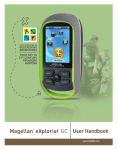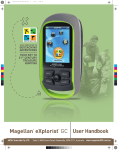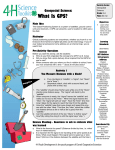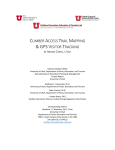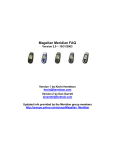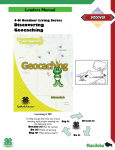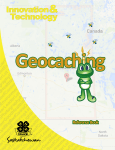Download An Introduction to Geocaching
Transcript
05_575716 ch01.qxd 8/4/04 9:33 AM Page 9 Chapter 1 An Introduction to Geocaching In This Chapter Understanding geoaching Finding out how geocaching works Discovering the benefits of geocaching Minimum requirements for geocaching G eocaching is a new, popular sport that relies on using a Global Positioning System (GPS) receiver, the Internet, and your powers of observation. In a nutshell, you find some stuff, take some stuff, leave some stuff, record it all in a logbook, and have fun! To elaborate a little more, someone, somewhere, hides a container filled with goodies (toys, travel memorabilia, costume jewelry, you name it). He or she then posts the location coordinates on the Internet along with a few clues. You visit a Web site database, get the coordinates, and use your GPS receiver to zero in on the geocache location. (Your GPS receiver usually won’t lead you directly to the cache, and this is where your powers of observation come into play in locating the cache’s hiding place.) Geocaching is pronounced GEE-oh-cash-ing. It’s not appropriate to pronounce cache as ca-SHAY, even if you are French. So unless you want some funny looks, stick with good ol’ cash. In a few short years, geocaching has grown incredibly popular. Relatively cheap and accurate GPS receivers and widespread access to the Internet have helped the sport flourish throughout the world. As of April 2004, the Geocaching.com site (www. geocaching.com; one of the first Web sites devoted to the sport and currently the largest geocaching site on the ’Net) had over 91,000 active geocaches listed in its database, spread out among 201 countries. And that number continues to grow each day. That’s a lot of caches out there to find! 05_575716 ch01.qxd 10 8/4/04 9:33 AM Page 10 Part I: Getting Ready to Geocache Although geocaching is based on a fairly simple idea, you need to understand a number of basic things — or at least be aware of them — before you get started. That’s what this chapter is all about. I show you exactly what geocaching is, how the sport got started, why you should geocache, and what you’ll need to get started with the sport. What Is Geocaching? If you’re reading this book, there’s a good chance you’ve heard about geocaching (or saw the title on a bookstore shelf, wondered what the heck it was, and started flipping through pages). The rising popularity of the sport has gotten a fair amount of media attention. Maybe you read a newspaper or magazine article about it or perhaps heard friends talking about some of their geocaching adventures. Geocaching technology Geocaching relies on two technologies: The Internet: Various Web sites list the coordinates of geocaches that you can search for. GPS: The satellite-based Global Positioning System (which everyone calls GPS for short) is used to help you zero in on the location of geocaches. (I discuss GPS in depth in Chapter 2. I even wrote a whole book about it: GPS For Dummies.) People use these two technologies together for finding and hiding goodie-filled containers that, by now, you’ve probably guessed are called geocaches. How geocaching got started Until 2000, the U.S. government degraded GPS signals using something called Selective Availability (SA). SA allowed the U.S. and its allies to use special GPS receivers to get very accurate location information while preventing civilian GPS receivers from having as much precision. In May 2000, SA was officially turned off (mostly because the U.S. government developed a way to degrade the accuracy of GPS to specific geographic regions). Suddenly, like magic, civilian GPS receivers that formerly were accurate only to 05_575716 ch01.qxd 8/4/04 9:33 AM Page 11 Chapter 1: An Introduction to Geocaching 11 about 300 feet became accurate to 30 feet. This new level of accuracy offered some interesting, creative possibilities. Three days after SA was turned off, Dave Ulmer posted a message in the sci.geo. satellite-nav USENET newsgroup with coordinates of a “stash” he had hidden that contained software, videos, books, food, money, and a slingshot. Earlier in the day, in the same newsgroup, Ulmer had proposed a worldwide “stash hunt,” where people would post GPS waypoints (coordinates saved in a GPS receiver) on the Internet that would lead searchers to hidden goodies. While Ulmer envisioned thousands of stashes tucked in places all over the world, he had no idea how popular his idea would become. By the end of May, in a Yahoo! Group devoted to the new sport, a member named Matt Stum suggested that the sport be called geocaching in order to avoid some of the negative connotations associated with drugs and the word stash. (A cache is a hidden place where goods or valuables are concealed.) Geocaching had a nice ring to it, and because it didn’t sound like a bad Cheech and Chong movie, the name stuck. The original cache is long gone, but there’s a newer one at the location and even a plaque that commemorates the world’s first official geocache (shown here). If you’ve ever in the Portland, Oregon area, think about making a pilgrimage to the shrine. (In Chapter 5, I tell you how to get there.) Geocaching explained Take a more detailed look at the steps that are involved in geocaching: 05_575716 ch01.qxd 12 8/4/04 9:33 AM Page 12 Part I: Getting Ready to Geocache 1. Someone hides a geocache. The cache consists of a waterproof, element-resistant container, such as a surplus ammo can or plastic tub, that’s filled with small trinkets such as costume jewelry, toys, flashlights, old coins, fossils, or just about anything else you could imagine. (Chapter 8 has everything you need to know about hiding caches.) The container also contains a logbook and a pen or pencil so whoever finds a cache can record their discovery. A sample geocache with its goodies is shown in Figure 1-1. Figure 1-1: A found geocache with goodies. 2. The geocache hider logs the GPS coordinates of the cache and a brief description on a Web site. Several different Web sites list the geocache coordinates. The largest and most popular site is www.geocaching.com. I primarily focus on this Web site throughout the book. 3. The prospective geocache finder (that’s you) is interested in searching for geocaches in a particular area and queries the Geocaching.com database. You can do this by entering a ZIP code, state, country, or other search options. A list of all the geocaches in the general vicinity is displayed. (Read more about this in Chapter 5.) 4. Look through the list of geocaches, select a few that look interesting, and enter their coordinates in your GPS receiver. 05_575716 ch01.qxd 8/4/04 9:33 AM Page 13 Chapter 1: An Introduction to Geocaching 13 5. Drive as close as you can to the geocache (unless you want some additional exercise by walking or hiking a bit farther) and start your search on foot, using the GPS receiver to guide you to the cache location. The GPS receiver won’t take you directly to the geocache — that would be too simple. Your GPS receiver will typically get you within 50 feet or so, and then you need to use your Sherlock Holmes powers of observation and deduction to locate the hidden cache. 6. Find the hidden container. If the cache is more deviously hidden, I give you some strategies in Chapter 7. 7. Open it up and see what’s inside. Whee! It’s Christmas morning, and you get to pick your present. 8. Exchange a trinket in the container that catches your eye with something you brought with you to trade. 9. Sign and date the logbook and carefully place the container back in its hiding place for the next geocacher to discover. 10. When you get home, log on to the Geocaching.com Web site, record your find, and write up a brief account of your adventures. (This is optional, but most geocachers do it.) That’s how geocaching works. Repeat the above steps over and over again, having as much fun as possible each time you go out looking for geocaches. (I go into a lot more detail with each of these steps throughout the book.) The original caches: Letterboxes The whole geocaching concept isn’t that new. Over 100 years ago, something similar developed in England: letterboxing. Letterboxing comprises placing a blank logbook and a custom-made rubber stamp in a waterproof container and then hiding it. Clues are distributed with the container’s location, and searchers armed with inkpads and notebooks try to find the hidden box. If they are successful, they stamp the logbook in the box with their own personal rubber stamp and also stamp their logbook with the box’s stamp. This low-tech version of geocaching is still very popular. Depending on whom you talk to, 10,000–40,000 letterboxes are hidden in England, and around 5,000 are lurking in the United States. Read more about letterboxing at www.letterboxing.org. 05_575716 ch01.qxd 14 8/4/04 9:33 AM Page 14 Part I: Getting Ready to Geocache Deciding to Geocache Why should you geocache? That’s a fair question, and I’m going to give you a number of reasons why you should get involved in the sport. (If you’re already an experienced geocacher, feel free to use some of these reasons to convince your friends and family members that they should give geocaching a try.) Master your GPS receiver: GPS receivers tend to have lots of different features and whistles and bells. Because successful geocaching depends on using a GPS receiver, the sport offers an excellent opportunity for you to get to know your receiver and how to use it. (I talk about how to use a GPS receiver in Chapter 3.) See new places: It’s pretty easy to get into a rut and never go anyplace new. People tend to be creatures of habit and always visit the same places, over and over again. Geocaching breaks you out of this repetitive cycle. You’ve now got a good excuse to visit places you’ve never been before, and because new geocaches are being added all the time, it’s pretty hard to get bored. Many people even incorporate geocaching into their vacations and business trips. Get some exercise: Face it; most people don’t get enough exercise. For whatever reasons, it’s easier just to sit on the couch and slowly (or quickly) put on the pounds. Geocaching is a great, low-impact way of increasing your fitness. It gives you a reason to get off the couch and get out in the fresh air to do some walking or hiking. Because geocaches are rated as to how difficult the terrain is and how far you’ll need to walk to get to a cache, you can select outings that are based on your current level of fitness. Challenge yourself: There’s scientific evidence that just like you need to exercise your body to be healthy, you also need to exercise your brain. Geocaching is a great way to do this because the sport involves a number of mental challenges. It’s like doing a crossword puzzle, plus you get the extra benefit of the physical exercise. You need to use • The Internet: To find geocaches you’d like to search for • Your GPS receiver: To get to the general vicinity of a cache • Your brain: To figure out just where the cache is hidden 05_575716 ch01.qxd 8/4/04 9:33 AM Page 15 Chapter 1: An Introduction to Geocaching 15 Hang out with friends and family: Geocaching can be an individual or group activity, and it’s a great excuse to get the family together or turn it into a social outing for a group of friends. Geocaching is even pet-friendly. Lots of geocachers take their dogs out with them on hunts. (Just remember to be considerate to others and bring a leash and a plastic bag.) Educate kids (and adults): Geocaching, which is starting to find its way into the classroom, is a great way to learn about history, geography, maps, and science. There are a number of ways how you can apply the basic principles of geocaching in an educational setting to make learning fun. (I discuss using GPS and geocaching in education in Chapter 11.) Build teams: Geocaching is also showing up as a unique tool for organizational development in building teams and developing leadership skills. Small groups are given GPS receivers and are asked to find geocaches and solve other related challenges, with effective teamwork a necessary ingredient for success. Who Geocaches? One of the nice things about geocaching is that just about anyone can do it; your gender, age, or economic status don’t much matter. (Geocaching is a relatively inexpensive sport when it comes to required equipment.) The main requirements are a spirit of adventure, a love of puzzles and mysteries, and a good sense of fun. Here are some of the people you’ll encounter in the sport: Computer geeks: Because geocaching involves gadgets (GPS receivers and the Internet), in the early days of the sport, a number of computer geeks were initially drawn to the activity. If you’re not a geek, don’t worry. You definitely don’t need a computer science degree, and geocaching has become so popular that the average-Joe non-geeks currently outnumber the technology geeks. Families and friends: Geocaching is a very family-oriented sport; more often than not, you’ll find couples, friends, and families out scouring the countryside looking for caches. Although you can certainly geocache by yourself, the social aspects of the activity and having more than one set of eyeballs to look for a well-hidden geocache are well suited to multiple-person outings. 05_575716 ch01.qxd 16 8/4/04 9:33 AM Page 16 Part I: Getting Ready to Geocache Outdoor recreationists: A fair number of hikers, hunters, fishers, rockhounds, and other types of recreationists have been using the outdoors long before GPS came into being. Because they typically already own a GPS receiver, many of these outdoorsmen and -women have added geocaching to their primary outside interests, getting in a little geocaching while they’re biking, hiking, fishing, four-wheeling, or engaging in some other sport or pastime. Retired folks: Geocaching is popular with the retired set because it’s a good excuse to get out of the house and do something interesting. Geocaches vary in how difficult the terrain is and how far off the beaten path they are. (Some caches aren’t even off the beaten path but are in easily accessible urban areas.) You can select geocaches to search for that match your physical abilities. Geocaching is also well suited for RVers and people who like to travel because they can go geocaching where they’re staying or on the way to their next destination. What You Need to Geocache The requirements for geocaching are fairly minimal. In fact, from a bare-bones standpoint, you need only two things: Geocache coordinates: If you don’t know where to look, it’s pretty hard to find a geocache (at least in most cases) There are numerous stories of non-geocachers accidentally stumbling onto caches, even some that were very well hidden. Geocachers turn to various Web sites on the Internet where they find tens of thousands of geocaches listed. Each of these caches has a set of coordinates associated with it, in a map grid system such as latitude and longitude or UTM (Universal Transverse Mercator). I tell you everything you need to know about how to find geocache location coordinates in Chapter 5. GPS receiver: With a GPS receiver, you enter the geocache coordinates, and the receiver guides you to the general vicinity of the geocache. (If you don’t already have a GPS receiver, read Chapter 2 for some pointers on selecting one.) You don’t need an expensive GPS unit with lots of features to geocache; a basic model priced around $100 will work just fine. (Don’t forget to bring the GPS receiver user manual, especially if you just purchased your receiver and are still trying to figure out how to use it.) 05_575716 ch01.qxd 8/4/04 9:33 AM Page 17 Chapter 1: An Introduction to Geocaching 17 Orienteering versus geocaching One big difference between orienteering and geocaching is that in the former, the control points are marked with very visible, orange and white flags. In geocaching, the caches tend to be carefully hidden out of sight. You can go geocaching without a GPS receiver and use only a map and compass. (My adventure racing team does this to practice our navigation skills.) This is more challenging and makes the sport more like orienteering, where you run around the woods trying to find control points as fast as you can, using a map and compass. Although the geocache coordinates and a GPS receiver are the two basic requirements for geocaching, I won’t kid you and say that’s all you need. Geocachers also tend to carry things like maps and compasses (which you can read how to use in Chapter 4), cellphones, food and water, and other pieces of gear. In Chapter 6, I give you a comprehensive and detailed list of other essentials that are commonly used when geocaching. Geojargon: Speaking the Lingo Like any sport or pastime, geocaching has its own language. Because the sport is so new, the jargon is still evolving, but here are some terms to be familiar with so when you talk to other people about geocaching, you’ll sound like a pro. Archived: Caches that no longer exist but still appear in a Web site database for historical purposes. A cache can be archived because it has been stolen, is no longer maintained, or does not abide by the guidelines for where caches should be placed. Cache machine: A preplanned event in a local area, where geocachers look for caches; the event can last hours or days. This is a marathon-endurance session of geocaching, where you try to find as many caches as you can in a set amount of time. The event is named after the dedicated geocacher BruceS (a true cache machine), who found 28 caches in 24 hours, totaling 86 finds in 5 days. 05_575716 ch01.qxd 18 8/4/04 9:33 AM Page 18 Part I: Getting Ready to Geocache DNF; Did Not Find: As in, did not find the cache. It happens to everyone, so don’t worry. If you didn’t find the cache, try again on another day. Event cache: A formal or informal get-together of geocachers. This can be to search for caches or just sit around and have a pizza and chat. FTF; First to Find: Bragging rights that you were the first person to find a newly placed cache. Geocoins: Custom minted coins or medallions designed to place in geocaches. Quite the prize if you find one in a cache. GPSR/GPSr: GPS receiver. Many people drop the R and just call a GPS receiver a GPS. Hitchhiker: An object that moves from cache to cache. A hitchhiker is marked with some instructions, telling the finding geocacher to take it and place it in another cache. McToys: Cheap trinkets left in a cache, like the toys that appear in fast-food kids’ meals. There are better things to leave in caches. Muggles: People you encounter on the trail who aren’t geocachers; from the Harry Potter stories. Neocacher: An inexperienced or newbie geocacher. Signature item: Something unique that a particular geocacher always places in a cache that he or she finds. Spoiler: Information that might give away the location of a cache. Swag: Goodies that you find in a cache; from the marketing term swag (or schwag) used to describe the promotional trash and trinkets (tchotchkes) handed out at trade shows. TNLN; Took Nothing, Left Nothing: Just what it sounds like. Also, TNLNSL, which means that the geocacher additionally signed the cache log. Travel Bug (TB): A type of hitchhiker that you mark with a special dog tag purchased from Geocaching.com. When TBs are found, their journey is tracked on the Geocaching.com Web site. Travel Bugs can have specific goals (as in, getting from point A to point B) or are just released into the world to see how far they can travel. 05_575716 ch01.qxd 8/4/04 9:33 AM Page 19 Chapter 1: An Introduction to Geocaching 19 Other caching pursuits In addition to geocaching, a number of other GPS-related activities have sprung up on the Internet. A few that you might be interested in include Geodashing: This is a contest in which random points are selected and players need to get within 100 meters of the location. There are no caches, hints, or terrain difficulty ratings, and the points can be anywhere on Earth. In fact, some locations can be impossible to reach. A new contest takes place roughly every month. The goal of the game is for teams to collect all the points first or to get as many as they can before the contest ends. For more details, check out www.geodashing.org. The Degree Confluence Project: This is an interesting project in which people use their GPS receivers to visit places where latitude and longitude lines converge. They take a digital picture, which is then published on a Web site. The goal is to map all the major latitude/longitude intersections for the entire Earth. For more information, go to www.confluence.org. Benchmark hunting: Benchmarks are permanent markers installed by the government for survey purposes. Over one-half million benchmarks have been installed in the United States. The most familiar type is a small, brass disk embedded into rock or concrete. The National Geodetic Survey (www.ngs. noaa.gov) maintains a list of the benchmarks and their locations. Chapter 9 tells you everything you need to know about getting started in this sport. GPS Drawing: This is an interesting form of art based on using your GPS receiver to record where you’ve been. For some amazing examples, check out the gallery at www.gpsdrawing.com. 05_575716 ch01.qxd 20 8/4/04 9:33 AM Page 20 Part I: Getting Ready to Geocache















